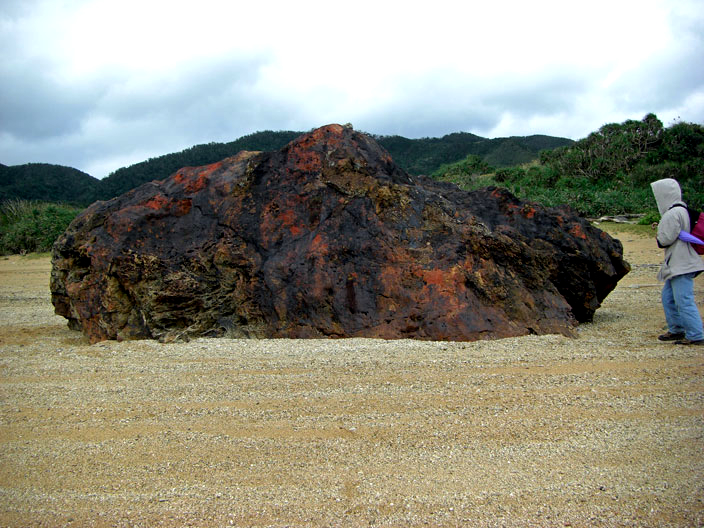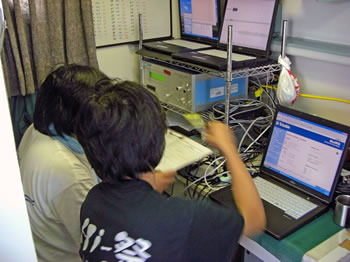Educational and Research Fields
[ Solid Earth Physics and Seismology ]
1. What do you learn?You will learn Earth’s shape and structure (geodesy, inner-Earth structure, sea-land distribution, topographical characteristics of the seafloor, etc.), and how it moves (plate dynamics, process of earthquake occurrence, and change to seafloor surface like seafloor landslide). To learn this, you will take subjects like Seafloor Earth Science, Seismology, Geodesy, and Solid Earth Physics.
2. Main Subjects
Seismology (Professor Mamoru Nakamura)
You will acquire general knowledge concerning earthquakes and their occurrence mechanism, and learn methods to investigate the inner Earth structure using seismic waves. The subject will touch on disaster prevention issues in the case of an earthquake or a tsunami, with a particular focus on Okinawa.

Photo: Investigating the rock left onshore by a tsunami (tsunami rock)
3. What type of research is being conducted?
In the earthquake research, we study the inner structure of Earth and changes in regions struck by a massive earthquake, using seismic wave records and satellite technology. We also use computer simulation for tsunami research.
When investigating seafloor active faults, which are what causes submarine earthquakes, it is critical to investigate the location, shape, and spread of the fault using ultrasonic waves, and check by direct visual observation the fault itself to determine its level of activity. Because of this, we also conduct broad-range oceanographic investigation on an exploration ship, and precision geological survey of the seafloor using a manned submarine research vehicle and an unmanned deep sea robot.
4. Recent Research Projects
“A region like Okinawa will never be struck by a massive earthquake,” or so we thought. Discoveries made while investigating Okinawa’s seafloor movements and earthquakes in the past have invalidated that accepted belief; in reality, a massive earthquake could very well strike Okinawa. There are still plenty of mysterious earthquake phenomenon yet uncovered. (Associate Professor Mamoru Nakamura)

Photo: Observing seafloor crustal movements from inside a ship.
Examples of Graduation Thesis Topics
・Landslide prediction in the southern region of Ishigaki Island using 3D stability analysis
・Changes in groundwater level at the time of the 1999 Ji-Ji (Taiwan) Earthquake
・Analysis of 太平洋完全横断地磁気三成分データ obtained from the marine research vessel Mirai
・Verification of the earthquake off the coast of Ishigaki Island on August 17, 2009, using tsunami numerical simulation
Instructors
Professor Mamoru Nakamura SeismologyI conduct research about earthquakes, crustal movements, and crustal structure. Okinawa is said to be a region where no big earthquake would hit, but I am studying the mechanism of big earthquakes that occurred in the Ryukyu Arc in the past, and also investigating locations with high potential for a big earthquake strike based on oceanographic survey results and numerical simulation.
Research unit website:https://seis.sci.u-ryukyu.ac.jp/
